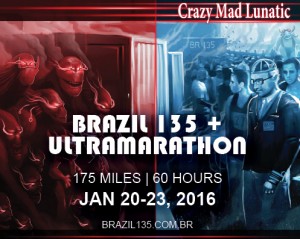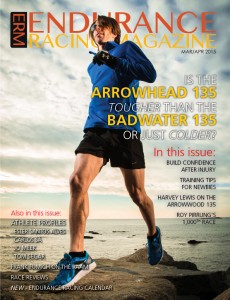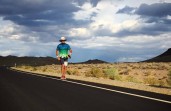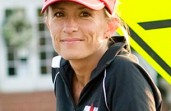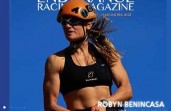The Badwater (BW) race starts at 100 miles. I learned the hard way many times and have been on an under 30-hour pace until I reached 100 miles and then crawled to the finish line. Get in your mind that the race starts at 100 miles, as the last 35 miles of the BW race to me are some of the hardest.
Follow these tips for a successful race planning and a successful race experience.
STRATEGY TO FINISH FAST: Go slowly in the early miles of the race. During the last 13-mile climb up to the finish line at the Whitey Portals one year I ran almost every step and had the 2nd fastest time up that climb of anyone in the race. It took me several years to learn to go out slower earlier in the race in order to finish fast! It works!
LOGISTICS: Plan your race a few months in advance. This includes hotel reservations, van rentals, plane reservations, and other plans for you and your crew. Make a packing list of all the supplies you will need in the vans for yourself and your crew so that once you arrive in Death Valley you wont have to go back to Las Vegas for supplies.
CREW: Pick a solid crew of experienced people who know you or know each other. Pick one person who will be the lead/chief crew person who will be in charge so you can focus on your race.
FINANCES: Be up front about the financial aspects of what you are willing to do for the crew. Make sure the crew understands any financial obligations so there are no issues after the race.
CLOTHING: Try every piece of clothing on several times and train with what you plan to wear in the race. This will save you the pain of bringing your entire closet. I personally prefer to wear clothing that is fast drying, light weight, and baggie.
For example, wear compression socks and shorts, but over the top I love the Nuu-Muu dresses because they are baggie and free moving; come on guys, you can wear a dress! Make sure your shoes work for you and you bring a pair one size larger in case your feet swell. I personally love to wear Crocs on the climbs; my feet feel like I am walking on marshmallows! Your socks are important! You dont want seams on your socks, and they need to fit so they dont move around in your shoes.
I have worn toe socks and then a pair of compression socks over the top. My feet were covered with
Hydropel and I didn’t get any blisters. Years ago my feet were so bad I had to have the blisters cut off my feet, so start to practice what you are going to do to with your feet. If you plan to tape your feet start doing it now so you know it works for you.
NUTRITION AND HYDRATION:
Practice it all in your training and dont try anything new come race day! Staying hydrated is vitally important. I carry a bottle and sip off it every 2 minutes; it just becomes a habit. Sip all the time. You need to like what you are drinking and know that your stomach is able to tolerate it. I learned over the years that my stomach does better with the fluid cool but not full of ice. When I put the ice cold drink to a very hot stomach it upsets my stomach.
A doctor friend of mine told me to imagine a car radiator that is overheated and then spray cold water on top of it, this is the same reaction to the stomach. When in doubt keep drinking and sipping water. There are several products out right now that are tasteless but also have some calories.
TRAINING: Set up a training schedule. The long, steep climbs at BW can be very tough if you haven’t trained properly—know you weakness.. For me personally I worked on running uphill. I suggest doing uphill and downhill repeats to get your legs ready for the climb
1. Mileage: The amount of miles each should train is very dependent on the person. Mix up your training to keep it fun and challenging and bump your miles up slowly so you dont get injured.
For example I have incorporated pulling a tire into my training for the past 25 years and have gotten many people doing the same, why? Because pulling a tire works the up and downhill muscles but it also helps build a strong core! If you plan to pull a tire please make sure you have it set up right for you so you dont injure your back.
2. Heat training: I’ve never lived in a hot climate nor have I ever done a ton of heat training and seem to have done just fine. I’ve trained with extra clothes on so that my body gets used to feeling of being overheated. I’ve also taken hot yoga classes and sat in the sauna for short periods of time. My students use hot yoga and sauna training but also train with more clothing on but not for long periods of time. Ice and cool water while in the race will help keep your body cooled down. I place ice on all the main places of blood flow. Under your hat, around your neck, under your job bra at your chest (yeseven some of my male students have worn jog bras). I carry a baggie of ice in my hand and move it from wrist to wrist.
3. Power Walking: I am a firm believer in cross training and having a strong core. Since power walking requires a strong core and is a necessary skill for success on long endurance races, I recommend learning how to become a powerful, aggressive power walker. Power walking, for example, has been the key to my success as I have been able to walk right past many people running. Power walking also helps you recover but it also moves you forward in an efficient way. I have been able to power walk up to 5.5 mph.
Marshall Ulrich used power walking successfully at Badwater. One year, he ran uphill but the next year he power walked all uphill and his finish time was within minutes of the year prior.
NEED MORE ADVICE? Ask all the questions you need to, I am happy to share with you my experiences and what I have learned along the way. Feel free to email me at [email protected] or send me a note via Facebook.
I also recommend you come out to the Tetons and train with Jay and I.
Happy training!


